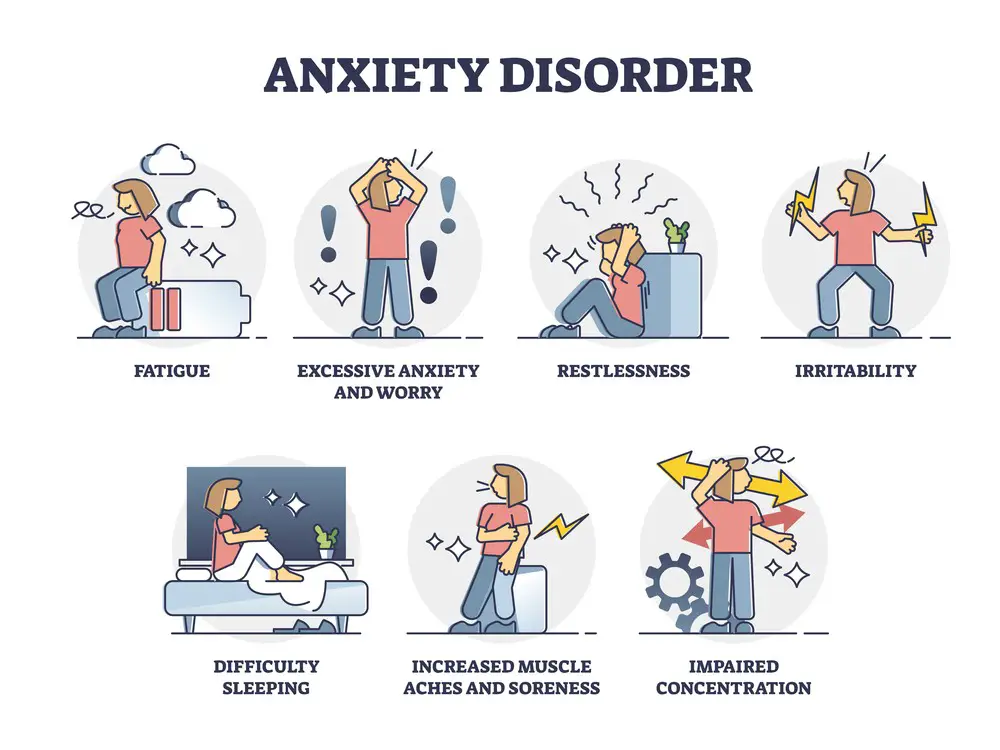As a BetterHelp affiliate, we receive compensation from BetterHelp if you purchase products or services through the links provided
Valium, also known as diazepam, is a fast-acting benzodiazepine that is often prescribed for individuals experiencing anxiety disorders. Its anxiety-relieving, muscle relaxant, and anticonvulsant properties have made it a popular choice for treating various conditions, including anxiety. Understanding how long Valium takes to work for anxiety is essential for those who rely on it for relief and peace of mind.
The time it takes for Valium to start working for anxiety depends on various factors, including the method of administration, dosage, and the individual’s age and weight. A 2022 study published in StatPearls found that Valium could take 1 to 3 minutes to start working when administered through the veins. However, the onset time for oral tablet form may be longer. It’s important to remember that each person’s experience with Valium may differ, so following the doctor’s directions and paying attention to your body’s unique response to the medication is crucial.
Key Takeaways
- Valium is a fast-acting benzodiazepine prescribed for anxiety disorders, among other conditions.
- The time it takes for Valium to work depends on factors like administration method, dosage, and individual characteristics.
- Valium can take as little as 1 to 3 minutes to work when administered intravenously, but the oral tablet form may take longer to have an effect.

Understanding Valium (Diazepam)
Valium, also known by its generic name diazepam, is a benzodiazepine medication. Benzodiazepines are a class of drugs that work as tranquilizers and are known for their calming effects. The FDA has approved Valium for various conditions, including anxiety disorders and seizures.
As an anti-anxiety medication, Valium acts on the central nervous system to promote relaxation and reduce anxiety symptoms. In addition to its anxiolytic properties, diazepam also serves as an anticonvulsant, effectively treating seizures.
When taking Valium, it’s essential to follow the medication guide provided by your healthcare professional. This will ensure that you’re using the drug safely and effectively. For instance, when consuming diazepam in tablet form, swallow it whole and avoid crushing, breaking, or chewing it.
Here’s a quick summary of what you should know about Valium and its uses:
- Valium is a brand name for diazepam, which belongs to the benzodiazepine class of drugs.
- The FDA has approved it as an anti-anxiety medication and anticonvulsant.
- It acts on the central nervous system to promote relaxation and reduce anxiety symptoms.
- Always follow the medication guide when taking Valium for the best results.
Remember, it’s crucial to use Valium only as your healthcare professional prescribes. If you have any concerns or questions about the medication, don’t hesitate to consult with your doctor or pharmacist.

How Valium Works for Anxiety
Valium, also sold under its generic name diazepam, is widely used to manage anxiety disorders and provide short-term relief for anxiety symptoms. It works by interacting with your central nervous system and enhancing the effects of a naturally occurring calming chemical called GABA (Gamma-Aminobutyric Acid), in your brain.
When you’re experiencing anxiety, your brain becomes overactive, leading to various symptoms such as tension, worry, and restlessness. Valium helps ease these symptoms by increasing the activity of GABA, which is responsible for reducing activity in different areas of the brain. As a result, it helps control your emotions, thoughts, and even automatic functions like breathing.
To give you an idea of how soon Valium can start working, it’s worth noting that when taken through the veins, it can take as little as 1 to 3 minutes to begin taking effect. However, if you’re taking the tablet form, it may take a bit longer to kick in.
Keep in mind that using Valium should always be done under the supervision of a healthcare professional, as there is a potential for dependence and withdrawal issues. When it comes to managing anxiety disorders, it’s essential to follow the instructions provided by your doctor and maintain open communication about your experience with the medication.
Key takeaway: Valium alleviates anxiety symptoms by boosting the activity of GABA in your brain, which calms the overactivity often associated with anxiety. Always consult with a healthcare professional for proper use and guidance.
The Onset Time of Valium
Valium, also known as diazepam, is a popular medication prescribed for anxiety relief. The time it takes to start working depends on the form of Valium you’re taking – liquid, tablets, or injection.
Tablets and Liquid: When you take Valium orally as tablets or liquid, you’ll typically feel the effects in around 30 minutes to an hour. For anxiety, the usual dose is 2mg, taken 3 times a day, but this can be increased to 5mg to 10mg, taken 3 times a day, if needed.
Injection: If you’re receiving Valium via injection, you’ll notice its calming effects much quicker. When administered through the veins, it begins working in just 1 to 3 minutes. This method makes it an effective option for individuals seeking immediate relief.
It’s crucial to follow your doctor’s instructions when taking Valium, as they’ll determine the best dosage and form for your needs. Remember, Valium is intended for short-term use, so avoid taking it longer than prescribed.
Key Takeaway: The onset time of Valium varies, with oral forms taking 30 minutes to an hour and injections taking 1 to 3 minutes. Always follow your doctor’s advice on dosage and usage to ensure a safe and effective treatment for anxiety.

Effect of Age and Weight on Valium Efficiency
When treating anxiety with Valium, it’s essential to understand how age and weight can impact the medication’s efficiency.
Adults’ typical dosage for managing anxiety ranges from 2 to 10 milligrams (mg) taken 2 to 4 times a day. However, older adults may require a lower initial dose of 2 to 2.5 mg taken 1 or 2 times a day, with the possibility of a gradual increase if needed. This is because older individuals might be more sensitive to the drug’s effects and face a higher risk of side effects.
Children are also prescribed different dosages based on their age and weight. For those 6 months and older, the initial recommendation is 1 to 2.5 mg administered 3 or 4 times daily. Like adults, a child’s doctor may adjust the dosage if necessary.
Regarding weight, it’s crucial to remember that the ideal dosage may vary depending on a person’s body mass. The general principle is that a lower dose is preferred to help minimize potential side effects. Your doctor will consider your weight when prescribing Valium and make adjustments accordingly.
It’s essential to follow your doctor’s prescribed dosage and schedule to experience the optimal effects of Valium for anxiety relief and to avoid potential health risks.
Remember to consult your healthcare provider if you have concerns or need adjustments to your Valium treatment plan. By staying informed and maintaining open communication, you can ensure that your experience with Valium is as safe and effective as possible.

Interactions and Side Effects
Valium can interact with other substances and medications, which may cause unwanted effects. It’s essential to be aware of these potential interactions and side effects to ensure the safe use of Valium for anxiety management.
- Alcohol: Mixing Valium and alcohol can have dangerous consequences. Both substances are central nervous system depressants, which may intensify the sedative effects, leading to drowsiness, difficulty breathing, and even accidental overdose.
- Drug Interactions: Valium can interact with various medications, causing side effects or altering efficacy. Always inform your doctor about all your medications and supplements to avoid harmful interactions.
Some common side effects associated with Valium include:
- Drowsiness: Valium can cause sedation, so you should avoid driving or engaging in hazardous activities until you know how the medication affects you.
- Confusion: This medication may confuse, especially in older adults. If you experience this, notify your doctor.
- Headache and nausea: These are common side effects that may occur when you start taking Valium. Drinking enough water and having small, frequent meals might help alleviate these symptoms.
- Blurred vision: If you experience any vision changes while taking Valium, consult your doctor immediately.
More severe side effects can happen, although they are rare. If you experience difficulty breathing or signs of an allergic reaction, such as swelling of the face, lips, tongue, or throat, seek medical attention right away.
Remember to inform your healthcare provider about any side effects or concerns you have while taking Valium for anxiety. Monitoring these potential interactions and side effects ensures the medication works effectively and safely.
Valium in Special Conditions
When considering using Valium to treat anxiety, it’s essential to be aware of its effects on specific conditions. Valium may not be appropriate for everyone, and certain conditions may require extra caution or avoidance of Valium altogether.
Pregnancy and Breastfeeding
Valium is generally not recommended during pregnancy as it may cause harm to the developing baby. If you are pregnant or planning to become pregnant, consult your doctor before using Valium. Additionally, Valium can pass into breast milk, so it is not recommended for nursing mothers. Your doctor will help you determine your situation’s best course of action.
Myasthenia Gravis
If you have myasthenia gravis, a condition that causes muscle weakness, Valium may not suit you, as it can further exacerbate muscle weakness. Talk to your doctor about alternative treatments that might suit your condition.
Sleep Apnea
Valium may cause respiratory depression, which could worsen sleep apnea, a condition marked by repeated breathing pauses during sleep. If you have sleep apnea, discuss the risks and benefits of using Valium with your physician.
Open-Angle and Narrow-Angle Glaucoma
Valium can be taken cautiously by individuals with open-angle glaucoma, a common eye condition involving increased pressure in the eye. However, Valium should not be taken by individuals with narrow-angle glaucoma, a more severe form of the condition, as it can lead to a rapid increase in eye pressure. Always talk to your doctor if you have glaucoma before starting Valium.
Liver Disease and Severe Liver Disease
Valium can be challenging for the liver to metabolize, so individuals with liver disease, particularly severe liver disease, may need to avoid Valium or use lower doses. Consult with your doctor about how your liver condition might affect Valium use and what other options might be available.
Cerebral Palsy
Valium is sometimes used to treat muscle spasms in individuals with cerebral palsy. However, it’s crucial to work closely with your doctor to determine the proper dosage and duration of treatment, as Valium can cause side effects that may interfere with daily functioning.
Remember, it’s vital to discuss your medical history and any pre-existing conditions with your doctor before starting Valium so they can help you assess the potential risks and benefits in your situation. Alternatives to Valium exist, so your doctor will help you find the best treatment option for managing your anxiety.

Valium Dependence and Withdrawal
Valium is a widely prescribed medication for anxiety disorders. However, it’s essential to understand that prolonged use can lead to dependence and withdrawal. This section will discuss how dependence occurs, the withdrawal process, and the symptoms you may experience.
When you use Valium for an extended period, your body can develop a physical dependence on the drug. This means that your system relies on the medication to function properly, and when you stop taking it, you may experience withdrawal symptoms. Valium, a long-acting benzodiazepine, might take longer for withdrawal symptoms than intermediate-acting medications like alprazolam.
Withdrawal symptoms vary depending on the individual, but some common ones include:
- Anxiety
- Insomnia
- Tremors
- Nausea
- Sweating
- Rapid heart rate
The severity of withdrawal symptoms may also depend on factors such as duration of use, dosage, and whether the individual has a history of alcohol or substance abuse.
Tips for Managing Valium Withdrawal:
- Consultation is Key: Before making any decisions regarding the discontinuation of Valium, consulting with a healthcare professional is imperative. They can provide a tailored tapering plan to minimize withdrawal symptoms and ensure safety.
- Gradual Taper: A gradual tapering off of Valium under medical supervision is preferable over abrupt cessation. This method helps in reducing the intensity and severity of withdrawal symptoms.
- Maximum Duration: It’s often suggested that benzodiazepines like Valium be taken for a short duration, ideally not exceeding 2-4 weeks, to prevent the development of dependence.
- Healthy Lifestyle: A healthy lifestyle with a balanced diet, regular exercise, and adequate sleep can support your body as it adjusts to the absence of Valium.
- Stay Informed: Be educated about the process; knowing what to expect can prepare you mentally and emotionally. Understanding the potential challenges can equip you with the resolve to stay committed to the withdrawal process.
- Support Systems: A solid support system, whether through friends, family, or support groups, can provide the encouragement needed during this period.
- Mindfulness and Relaxation Techniques: Practices like meditation, yoga, and breathing exercises can be beneficial in managing anxiety and other withdrawal symptoms.
- Consider Alternative Therapies: Explore other non-pharmacological therapies for anxiety management. Cognitive-behavioral therapy (CBT) and other forms of psychotherapy have proven effective in addressing anxiety disorders.
- Maintain Regular Follow-Up Appointments: Regular check-ins with your healthcare provider can help monitor your progress, adjust your tapering schedule if necessary, and address any concerns that arise.
Valium Dosage Information
When taking Valium for anxiety, following the appropriate dosage guidelines is crucial. Your doctor will determine the best dosage for you based on the severity of your anxiety and individual needs.
For adults with anxiety disorders, the usual daily dose ranges from 2 to 10 mg, taken 2 to 4 times throughout the day. In cases of acute alcohol withdrawal, a higher dosage is recommended: initially 10 mg, 3 or 4 times during the first 24 hours, and then reduced to 5 mg, 3 or 4 times daily as needed.
It’s important to remember that Valium should not be given to children under six months. For older adults, dosages may be lower, typically at 2 to 2.5 mg 1 or 2 times daily. Your doctor may then gradually increase the dose as needed.
Sometimes, life can get in the way and make you miss a dose. If this happens, take the missed dose as soon as you remember. But be cautious if it’s close to the time for your next scheduled dose—don’t double up on the medication. Instead, skip the missed dose and continue with your regular dosing schedule.
Keep in mind:
- Always follow your doctor’s dosing instructions.
- Monitor your response to Valium and notify your doctor if you experience adverse side effects or the medication doesn’t seem to work.
- Avoid taking more or less than the prescribed dosage to minimize risks.
By following these guidelines, you can use Valium safely and effectively to help manage your anxiety.

Risks and Precautions of Valium Use
When using Valium to treat anxiety, it’s essential to be aware of the risks and precautions associated with its use. Valium can have various side effects; taking it without proper guidance can lead to unwanted consequences.
One risk to consider is the potential for causing drowsiness and unresponsiveness while taking Valium. This can make activities like driving dangerous, as it may impair your ability to focus and react swiftly. Therefore, avoiding driving or operating machinery is wise until you know how the medication affects you.
Valium can also increase the risk of falls in older individuals due to its muscle-relaxant properties and the potential for dizziness. To minimize this risk, try to move slowly and deliberately when changing positions, like getting up from a seated or lying position.
Since Valium has the potential to be habit-forming, it’s crucial to use it only as prescribed by your doctor. Avoid taking it for extended periods or increasing the dosage without discussing it with your healthcare provider. This helps prevent the development of dependence and reduces the risk of an accidental overdose.
Combining Valium with alcohol is a significant risk, as both substances can intensify each other’s effects. This may lead to increased drowsiness, unresponsiveness, and a higher likelihood of accidental overdose. Make sure to avoid alcoholic beverages while taking Valium to prevent such risks.
In summary, when using Valium for anxiety, ensure to:
- Avoid driving or operating machinery
- Move slowly to prevent falls
- Follow your doctor’s prescription to prevent habit-forming
- Refrain from consuming alcohol during treatment
By being aware of these risks and precautions, you can safely and effectively manage your anxiety with Valium.
Valium in Seizure Disorders
Valium, also known as diazepam, is a medication commonly used for the short-term treatment of anxiety and seizure disorders. Its effects include anxiety-relief, muscle relaxation, anticonvulsant properties, and even amnesia in some cases.
Seizure disorders involve sudden, uncontrolled electrical disturbances in the brain that can cause various symptoms such as:
- Tics and twitching
- Convulsions
- Loss of consciousness
- Stiffening of muscles
Valium’s Role in Managing Seizures:
Valium can help manage seizures by slowing down the excessive electrical activity in the brain, which ultimately reduces the frequency and severity of seizure episodes. Following your doctor’s recommendations on the proper dose is essential to ensure optimal seizure control.
- Valium can be habit-forming, so it’s generally prescribed for short-term use only.
- It’s crucial to never abruptly stop taking Valium, as doing so can result in withdrawal symptoms like insomnia, anxiety, and even seizures themselves.
Considerations for Valium Use in Seizure Disorders:
- Always consult your doctor about potential side effects and interactions with other medications.
- Be cautious when engaging in activities that require concentration and alertness, as Valium can cause drowsiness.
- Keep track of your seizure frequency and any changes to your symptoms to help your doctor adjust your treatment plan as needed.
Key Takeaway:
Valium can be an effective option for managing seizures in the short term. Follow your doctor’s advice on proper dosing and be aware of possible side effects, interactions, and withdrawal symptoms. Monitoring your seizure episodes will give your doctor essential information to tailor your treatment plan to suit your needs.
Valium for Muscle Spasms
Dealing with muscle spasms can be uncomfortable and frustrating. Valium, a medication containing diazepam, might be just what you need to find relief. Not only is Valium effective at treating anxiety, but it also works wonders for muscle spasms and muscle weakness.
When you’re facing muscle spasms, your doctor may prescribe Valium to help relax your muscles and alleviate the spasms. The dosage for muscle spasms in adults usually starts at 2mg to 15mg per day. This could be administered as 1mg twice a day, potentially increasing to 5mg taken three times a day, depending on the severity of your condition.
Some benefits of using Valium for muscle spasms include:
- Fast-acting relief: Valium works quickly, making it an ideal choice for those sudden and unexpected muscle spasms.
- Flexibility in dosage: Your doctor can adjust the dosage based on the severity of your muscle spasms and any potential side effects.
- Multifaceted treatment: In addition to treating muscle spasms, Valium can also address anxiety and sleep issues accompanying your muscle spasms.
To make the most of Valium for your muscle spasms, keep these tips in mind:
- Always follow your doctor’s instructions and recommended dosage.
- If you experience side effects, consult your doctor to see if a dosage adjustment is necessary.
- Avoid combining Valium with other central nervous system depressants or alcohol, which can increase drowsiness or more severe side effects.
In conclusion, Valium can effectively treat muscle spasms and muscle weakness, providing relief and improved quality of life. Remember to consult your doctor before starting Valium, and always follow their instructions for the best results.

Potential for Valium Abuse
Valium, as a benzodiazepine medication, can help treat anxiety disorders. However, being aware of its potential for abuse and addiction is crucial. When not used according to medical advice, Valium may pose significant risks to your health and emotional well-being.
It’s essential to understand that Valium is only meant for short-term use. Prolonged usage can lead to dependence, and it’s common for people to develop a substance abuse problem. Some risks associated with Valium abuse include:
- Developing a tolerance that requires increased doses to achieve the same effects
- Experiencing withdrawal symptoms when attempting to reduce or stop Valium use
- Involving in risky behaviors while under the influence of the medication
If you notice any signs of addiction or dependence, it’s important to seek professional help. Here are a few tips to avoid Valium abuse:
- Follow your doctor’s prescription, and do not take more than the recommended dose
- Communicate with your healthcare provider about your concerns or if you feel the need for a higher dose
- Seek alternative ways to manage your anxiety, such as therapy, meditation, or exercise
Valium can be an effective treatment option for anxiety, but it’s crucial to be attentive to the potential risks associated with abuse and addiction. Always use Valium under the guidance of a healthcare professional and consider additional strategies to support your mental health.
Gauging the Effectiveness: Signs Valium is Working
Once Valium is introduced into the system, its effectiveness can be observed through a few telling signs. Here are some indicators that the medication is functioning as intended:
- Reduced Anxiety: The primary sign that Valium is working is a noticeable reduction in anxiety. Individuals may feel more relaxed, less jittery, and may exhibit a calmer demeanor.
- Improved Sleep: For those who experience insomnia due to anxiety, a marked improvement in sleep quality might indicate Valium’s effectiveness.
- Muscle Relaxation: Valium also acts as a muscle relaxant. Hence, eased muscle tension or reduced muscle spasms can indicate the drug’s efficacy.
- Mitigated Seizure Activity: In cases where Valium is used as an anticonvulsant, a decrease in seizure frequency or intensity is a positive sign.

Red Flags: When Valium Might Not be Working
It’s equally important to recognize when Valium may not be working optimally. Here are some warning signs:
- Persistent Anxiety: If anxiety symptoms continue unabated or worsen, it might suggest that Valium is not working as it should.
- Unabated Insomnia: Continued sleep disturbances despite medication may be a red flag.
- No Relief in Muscle Tension: If muscle tension or spasms persist, it might indicate a need for dosage adjustment or alternative treatment.
- Continued Seizure Activity: Persistent or increased seizure activity can indicate that Valium is not effectively managing the symptoms.
Who is Valium For? Unveiling the Ideal Candidates
Valium is a versatile medication that caters to a variety of individuals and conditions:
- Individuals with Anxiety Disorders: Valium is primarily used to alleviate symptoms of anxiety disorders, providing a calming effect that helps manage daily stressors.
- Muscle Spasm Sufferers: Those experiencing muscle spasms can find relief with Valium, thanks to its muscle relaxant properties.
- People with Seizure Disorders: Valium can be an effective treatment for managing seizures, especially in acute settings.
- Individuals undergoing Alcohol Withdrawal: Valium can also be used to manage symptoms of alcohol withdrawal, aiding in detoxification.
It’s imperative to note that Valium should only be used under the strict guidance of a healthcare professional. Its misuse can lead to dependency, adverse reactions, and other unwanted outcomes. The key to successful treatment with Valium lies in adhering to the prescribed regimen, maintaining open communication with your healthcare provider, and paying heed to your body’s responses to the medication.
Ongoing Research and Studies on Valium
In recent years, researchers have been focusing on understanding the efficacy of Valium (diazepam) for treating anxiety and other related conditions. One noteworthy study in 2022, published in the journal StatPearls, reported that Valium could start working within 1 to 3 minutes when administered intravenously1. This rapid onset is a significant factor in its popularity for those suffering from intense anxiety or panic attacks.
Although Valium is widely used, its long-term use can lead to addiction and cognitive impairment, especially in older individuals2. To address these concerns, researchers aim to pinpoint the cellular mechanisms responsible for these side effects. Through ongoing research, experts hope to propose alternative treatments for those prone to addiction or cognitive decline before resorting to benzodiazepines.
As we continue to learn more about Valium’s benefits and risks, clinicians must balance its effectiveness with potential downsides. Some strategies to ensure the safe and effective use of Valium include:
- Carefully selecting patients who might benefit from Valium
- Favoring clinical settings where Valium is more likely to be beneficial
- Focusing on lower doses and shorter durations of treatment
Studying the long-term effects of benzodiazepines (BZDs) like Valium is vital for the medical community. Patients using Valium for fits or episodes should know its potency and explore alternative treatments with their healthcare provider.
Key takeaway: Ongoing research reveals the potential benefits and risks of Valium for anxiety treatment. By understanding these factors, clinicians can make informed decisions on how best to use Valium in specific cases while prioritizing the needs and well-being of their patients.
Frequently Asked Questions
How long before diazepam relieves anxiety?
Diazepam, commonly known as Valium, works relatively quickly when taken for anxiety. If administered intravenously, it can start working in just 1 to 3 minutes. However, the effects may take longer when taken orally in tablet form. Remember that individual experiences may vary, so consult your doctor for the most accurate information for your circumstances.
What is the duration of a 5mg Valium?
The duration of a 5mg Valium can vary for different individuals. Generally, Valium’s half-life ranges between 20 to 100 hours, with its primary effects usually lasting for a few hours. Remember that various factors, such as age, metabolism, and dosage, can impact the duration of Valium’s effects. Speak with your doctor for personalized advice about your dosage and potential effects.
Can Valium help with sleep?
Yes, Valium can help with sleep due to its anxiety-relieving and muscle-relaxant properties. In some cases, doctors may prescribe Valium as a short-term treatment for anxiety-related sleep issues. However, it’s essential to use Valium only as prescribed by your healthcare provider for this purpose, as the medication can be habit-forming when used inappropriately.
Does diazepam cause sleepiness?
Diazepam does have the potential to cause sleepiness as a side effect, along with other effects such as dizziness, fatigue, and muscle weakness. It’s crucial to avoid driving or operating heavy machinery while under the influence of diazepam. If you are concerned about this side effect, discuss it with your doctor, who can help you find an appropriate solution.
What to expect from 5mg of diazepam?
Taking 5mg of diazepam can relieve anxiety muscle spasms and even help induce sleep in some cases. It’s essential to follow your doctor’s prescription and be aware of potential side effects such as dizziness, sleepiness, and muscle weakness. It’s also important to note that the effects of diazepam can vary between individuals. Talk to your healthcare provider if you have concerns about how the medication affects you.
How often is Valium prescribed for anxiety?
The frequency with which Valium is prescribed for anxiety can vary based on the severity and duration of your symptoms. A typical prescription might recommend taking Valium 2 to 4 times per day. It’s important to note that Valium is usually prescribed for short-term treatment and not intended for long-term use. Be sure to follow your doctor’s instructions about how often to take Valium and for how long.
Key takeaway: Valium, or diazepam, can relieve anxiety and help with sleep, but it’s essential to use it only as your doctor prescribes. Be aware of potential side effects and follow your doctor’s instructions for frequency and duration when taking Valium.
About Jacob Maslow
After surviving the traumatizing events of 9/11, I took it upon myself to heal through helping others. I’m the primary caregiver of my children and understand from first-hand experience the lonely paths you have to walk as a partner and parent when leaving an unhealthy relationship.
We’re all echoing in a dark space that doesn’t have to be this empty, and that’s been my mission since finding solace and recovery in therapy: To help comfort others who are still in shock and at the prime of their struggle.
I came across BetterHelp after searching for this type of community. I wanted to belong to a body of proactive therapists and supportive therapy veterans that allowed me to see other sides of the story.
It was unconventional, and that’s what attracted me most. During my most challenging times, when my ex-wife completely cut me off from my children, I found comfort and clarity through BetterHelp.
Instead of being chained to a strict therapist recommendation, I was in charge of who I felt understood my struggle most. That allowed me to find my true peace, as I was reunited with those who read behind my words and had first-hand experience with my trauma.
Recovery is a choice; with BetterHelp, that choice will be a few clicks away. You can join their couples-oriented platform, Regain.us, for those stuck with family estrangement and toxic relationship patterns.

- Stress Management: What is the Relationship Between Stress and Addiction? - June 28, 2024
- Exploring Techniques to Maintain a Healthy Lifestyle without Drugs - May 28, 2024
- How Acupuncture Helps Treat Chronic Fatigue Syndrome - May 28, 2024
This site contains affiliate links to products. We will receive a commission for purchases made through these links.




